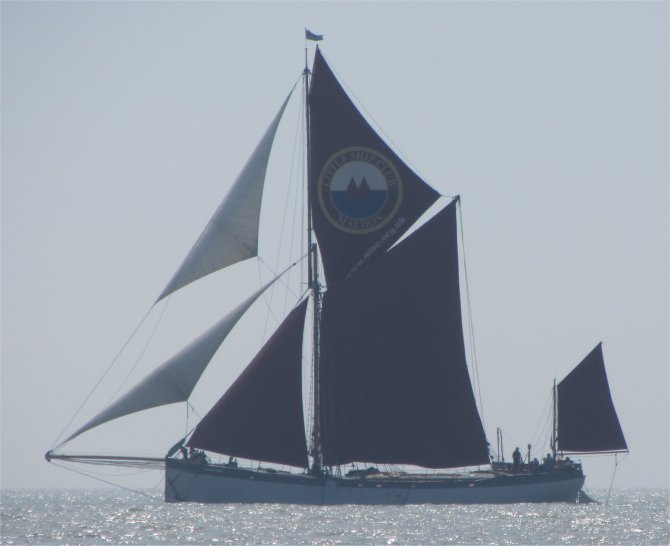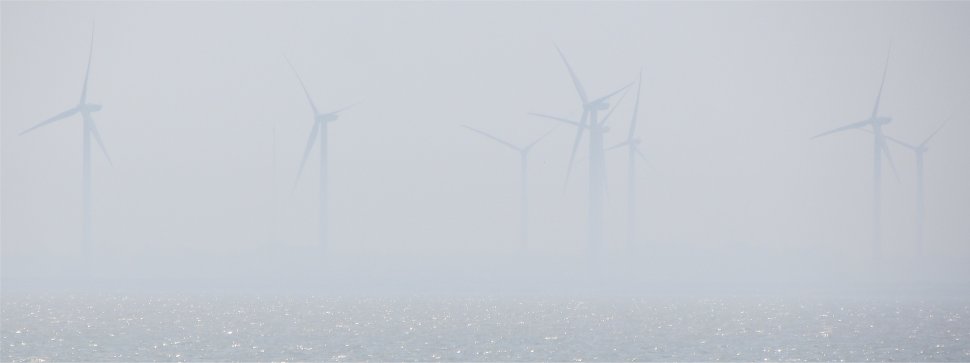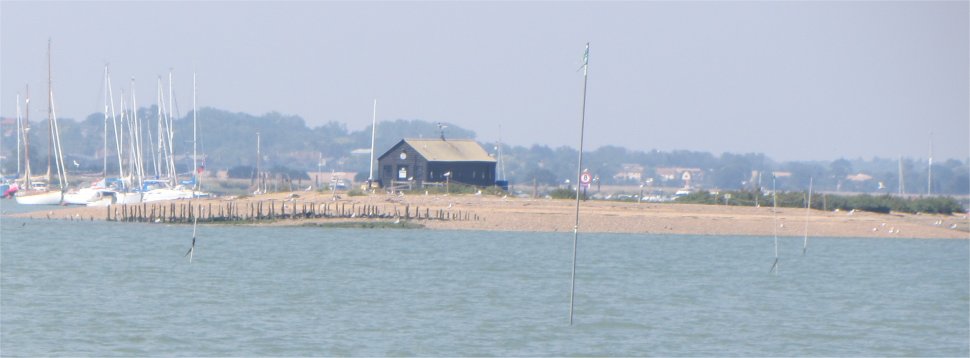 Blue Mermaid in the Sea Mist |
We pulled into the lock behind the Dutch boat that was heading for Wolverstone. Our passage out into Felixstowe harbour was hassle free, and we were motoring past massive containerships by 10am. Further out we crossed paths with a few yachts, a windfarm support vessel hurtled off towards the Gunfleet Windfarm, and a 394' long dredger was slowly gulping up a long narrow strip of seabed. Opposite Walton we admired a beautiful barge, the Blue Mermaid, in full sail; probably using the tides to get up to Ipswich.
A lobster pot boat inspired a torrential outburst of abuse from Rex, and sure enough, we soon found ourselves drifting with the genoa out through a minefield of lobster pots. "I don't believe it," moaned Rex, "Nelson never had this trouble."
We drifted down the Wallet with a refreshing breeze still in our genoa; a perfect way to end our trip. But life never runs smoothly, and a drop in the breeze reduced our speed to a heart-stopping 2.3 knots, necessitating resorting to engine power.
 Dengie Peninsula Wind Turbines Materialising in the Sea Mist |
The two looming buildings of Bradwell Nuclear Power Station materialised before us; almost back to port. We had time to kill before Duonita could get access into her berth, so when we reached the Nass, we made a decision to head up the channel to Mersea.
Mersea Island is the most easterly inhabited and publicly accessible island in the United Kingdom and is one of 43 (unbridged) tidal islands which can be accessed on foot or by road from the British mainland. Many vessels were riding on buoys all around the muddy creeks to the southwest of the island. We motored past the uninhabited Cobmarsh and Packing Marsh Islands.
 The Packing Shed |
In March 1894, Mersea men were infuriated to see Burnham boats dredging off Mersea. A small armada set forth with large shovels and sent the invaders packing. As a result, six local men were charged at Chelmsford Court with piracy on the high seas. Some 300 men from Mersea and Tollesbury marched to the courtroom and two MPs and various local landowners spoke in their defence.As a result, the men won their case and an Act of Parliament subsequently redefined the law.
Over the years a series of storms have seen generations of the Shed severely damaged. Oyster packing continued until the late 1950's, when the industry collapsed as a result of the first post-war oyster disease. After that the Shed was used for storing fishing gear, but gradually that use declined and it was eventually left to rot. However, the Shed has been restored for posterity by a group of local volunteers.
Today, it remains the property of the Tollesbury & Mersea Native Oyster Fishery Company, but is now leased to the Packing Shed Trust at a peppercorn rent. Inside, the history of the Packing Shed is explained by various original oyster-fishing artifacts, together with old photographs and documents on display. The Shed is used by various organisations, including local charities as well as individuals, for a variety of outdoor activities including overnight camping, bird watching, art classes, birthday parties, wedding receptions and other special occasions.
We edged our way a short way up the narrow Salcott Creek, with moored boats to our port, and withies betraying submerged oyster beds on our starboard.
 Heading up Salcott Creek |
It was great to get away together for another adventure, but it is always good to return safely to home port.
